农田施氮对水质和氮素流失的影响
2016-11-29张亦涛刘宏斌王洪媛翟丽梅雷秋良任天志
张亦涛,刘宏斌,王洪媛,翟丽梅,刘 申,雷秋良,任天志
1 农业部面源污染控制重点实验室, 中国农业科学院农业资源与农业区划研究所, 北京 100081 2 农业部环境保护科研监测所,天津 300191
农田施氮对水质和氮素流失的影响
张亦涛1,刘宏斌1,王洪媛1,翟丽梅1,刘 申1,雷秋良1,任天志2,*
1 农业部面源污染控制重点实验室, 中国农业科学院农业资源与农业区划研究所, 北京 100081 2 农业部环境保护科研监测所,天津 300191
基于ISI Web of Science数据库,利用文献计量学方法分析了自1957年以来各国在农田氮流失领域的研究发展态势,综述了农田氮流失特征及氮流失防控措施。结果表明,目前各国对农田氮流失的研究主要集中在施氮对水体水质的污染和监测方法上,涉及的关键词主要有Groundwater、Water quality、Surface water、Nitrate pollution、Eutrophication、Contamination、Nonpoint source pollution、Lysimeter、Runoff、Subsurface drainage等。中国、美国和加拿大等农业大国的研究机构在这一领域的研究成果最多发文量最多的期刊主要分布在荷兰、美国和中国。文献分析表明,受降水、地形、土壤、施肥等诸多管理措施的影响,不同区域的农田氮流失量差别很大,中国各类农田的氮流失量(13.7—347 kg/hm2)明显高于欧美国家(4—107 kg/hm2)。我国单位面积化肥(357.3 kg/hm2)和氮肥(165.1 kg/hm2)施用量均远高于世界平均用量(87.5 kg/hm2和52.9 kg/hm2),当季氮肥利用率(17%)却明显低于世界平均水平(58%),表明氮肥施用过量且利用率过低是造成氮流失的关键因素。综合分析农田氮流失防控措施发现,从源头控制氮流失是最有效的措施,优化农艺管理措施和氮迁移过程拦截等分别可减少15%—92%、46%—77%的氮素流失,其中针对农田适宜施氮量的研究最多。然而,面对粮食生产需求与资源短缺、水体水质持续恶化的现状,未来的研究重点应从简单的表观平衡向整个农田生态系统的氮素循环过程转变,更为迫切的是加快探索以水质保护为目标的化肥氮施用阈值(造成环境污染的临界施氮量),并推广示范这些有效的氮流失防控措施。
农田施氮;Web of Science;水体水质;氮流失;防控措施;施氮阈值
A bibliometric analysis of status and trend of international research on field nitrogen application effects on nitrogen losses and water quality
氮是作物生长和产量形成的最重要营养元素,氮肥施用为满足全球70亿人口的粮食需求做出了突出贡[1],农田氮肥施用对发达国家粮食增产的贡献率在40%以上[2],对发展中国家粮食增产贡献率高达55%[3]。迫于人口持续增长对粮食需求的压力,农田生态系统氮素投入越来越多,然而,农田氮素利用率却逐年下降,投入的过量氮素或者残留在土壤中,或以氨、氧化亚氮的形式挥发,或以径流、淋溶等方式进入水体,即使是残留在土壤中的氮素,最终也会以挥发或流失的形式进入环境[4],造成了严重的环境风险或直接的环境污染。然而,作物对氮素的利用效率受气候、土壤、农田管理等多因素的影响,当前全球大多数作物种植系统的氮盈余量大[5],氮肥利用率低[6],水溶性氮流失及气态氮损失量高[7],农田氮流失严重,并成为农区地表水富营养化和地下水硝酸盐污染的重要原因[8-9]。
过量施氮及施氮后的损失造成了严重的环境问题[10],氮素管理与环境质量及人类健康的关系受到了广泛的关注,多年来,相关研究论文发表数量持续增长。文献计量学是对文献进行定量分析研究的科学,被广泛应用于分析各种学科研究的科研成果和研究趋势[11- 14]。ISI (Institute for Scientific Information)Web of Science数据库收录了全球8700多种各学科领域的领先期刊的SCI(Science Citation Index)论文,覆盖面最广,是文献计量分析最常用的数据库[15]。针对特定领域研究的文献计量分析可以多方面的揭示各领域研究发展态势和研究热点问题,为科研工作者探索学科新方向提供依据。
本文将从农田施氮对水体水质的影响、氮流失影响因素及防控措施等多个角度,探讨农田氮流失(农田向水体迁移损失的那部分氮,不包括气态形式的氮损失)对水体水质的影响发展态势,揭示影响氮素流失的主要影响因素,分析当前有效的氮流失防控措施,并明确优化氮肥施用量是从源头控制氮素流失的最有效措施之一,为确定基于水质保护的化肥氮施用阈值(即水质污染突变时的农田施氮量)提供依据。
1 农田施氮对水体水质影响的文献计量分析
农田施用的氮肥除被作物吸收利用外,剩余氮素大部分以挥发、淋溶或径流等形式损失进入大气和水体[16],硝态氮和铵态氮是流失氮素的主要形态,水分扰动产生的悬浮土壤颗粒及其溶出的养分可随地表径流水迁移流失[17],而由水分溶解的土壤氮也可垂直向下迁移出根区[18]。
早在19世纪,科学家们就注意到了氮素流失带来的环境问题,并将用于研究水分平衡的渗滤池技术应用到了元素的淋失研究[19],此后100a间研究的主要内容是对养分淋失量及其形态进行观测,但并未深入研究淋洗的剖面特征和动态。20世纪40年代以来,氮肥大量施用造成的严重环境问题凸显出来,引发了70年代以来的氮素问题研究热潮,农田氮素迁移逐渐受到重视,15N示踪技术开始应用于土壤肥料效应研究,此后科学家开始关注区域尺度上的氮素流失情况,并对影响流失的因素和有效控制措施进行了深入研究和模拟,同时多学科交叉合作日益增多,并形成了诸多新兴研究领域。1976年,美国最早提出了面源污染的概念,并进行了面源污染研究[20- 21];20世纪80年代初,我国湖泊、水库富营养化调查和河流水质规划是中国面源污染研究的重要开端,但该时期我国农田肥料投入量并未显著增加,农田养分的流失监测也未作为研究的重点,然而随着氮肥施用量的不断增加和农田灌溉条件的改善,面源污染问题日益突出,相关研究迅速发展起来,自20世纪90年代起,我国的农田面源污染实地监测也开展起来,氮流失问题备受重视[22]。
以ISI Web of Science数据库的全部期刊为检索对象,限定发表时间为1957年至2014年8月,对“农田氮肥施用”主题的SCI论文进行检索、数据清理、文献分类和主题分析,检索策略:(TOPIC: ((Farmland or field or agriculture or farming) and (“nitrogen fertiliz*” or “N fertiliz*” or“fertiliz* nitrogen” or “fertiliz* N”))),共检索出全部论文7460篇,然后从7460篇论文的关键词中检索出与“水体水质”相关的文献(共305篇),此类文献主要涉及氮肥施用对地下水、地表水水质的影响及其施用造成的硝酸盐污染、水体富营养化等。
对检索出的相关文献利用Excel统计数据信息,利用高频关键词和相关关系图对研究热点进行研究分析,采用发文数量和被引频次对研究机构、出版期刊等进行分析,统计分析过程中均选择第一作者、第一研究机构。利用汤森路透公司研发的TDA(Thomson Data Analyzer)软件,将主题关键词与全部关键词进行相关分析组成相互关系数矩阵,并据此绘制相互关系图,相关关系图揭示了各关键词之间关联性的紧密程度,图中点的大小表示包含这一关键词的文献量多少,点之间线的粗细表示两个关键词之间的相关程度,线越粗相关程度越紧密。
1.1 研究热点
农田氮素施用对水体水质的影响研究中涉及的高频关键词主要涉及到与水体类型相关的如Groundwater、Water quality、Surface water、Wastewater等,与水体污染相关的如Nitrate pollution、Eutrophication、Contamination、Nonpoint source pollution、Nitrogen pollution等,与含氮污染物相关的如Nitrate concentration、Nitrogen availability、Nitrate nitrogen、Nitrate-N等,还有与氮素流失监测相关的Runoff、Lysimeter、Subsurface drainage等(表1)。通过绘制这些高频词之间的相关关系图,发现各主题词之间的关联关系(图1),地下水(Groundwater)、水质(Water quality)、氮(Nitrate)、磷(Phosphorus)、农业(Agriculture)、施肥(Fertilization)、污染(Pollution;Contamination)和环境(Environment)之间关联密切;说明农田化肥的施用与面源污染尤其是水体水质是存在密切联系的,当前的农田施肥已经导致了水体中养分含量的变化。此外,水稻田(Paddy field)的氮素损失(Nitrogen loss)以及氨(Ammonia)的关联关系也较为集中。
1.2 研究机构
开展农田氮肥施用对水体水质研究的机构很多,但发表SCI论文最多的10个研究机构主要分布北美和亚洲的中国,其中有5家美国研究机构、4家中国研究机构、1家加拿大研究机构(表2)。中国科学院在该领域发表了26篇SCI研究论文,排名全球第一,美国农业部排名第二,发表SCI论文22篇,加拿大农业及农业食品部和中国农业大学排名并列第三,各发表SCI论文10篇。这些关注农田氮肥施用与水体水质关系的研究机构主要分布在农田面积大、农业生产活动频繁的国家,这些国家的农田氮素投入均很大,而作物每年从农田带走的氮素却极其有限,部分农田氮流失进入水体并不断累积从而导致水质下降,直接威胁人们的饮水安全,因此备受关注。
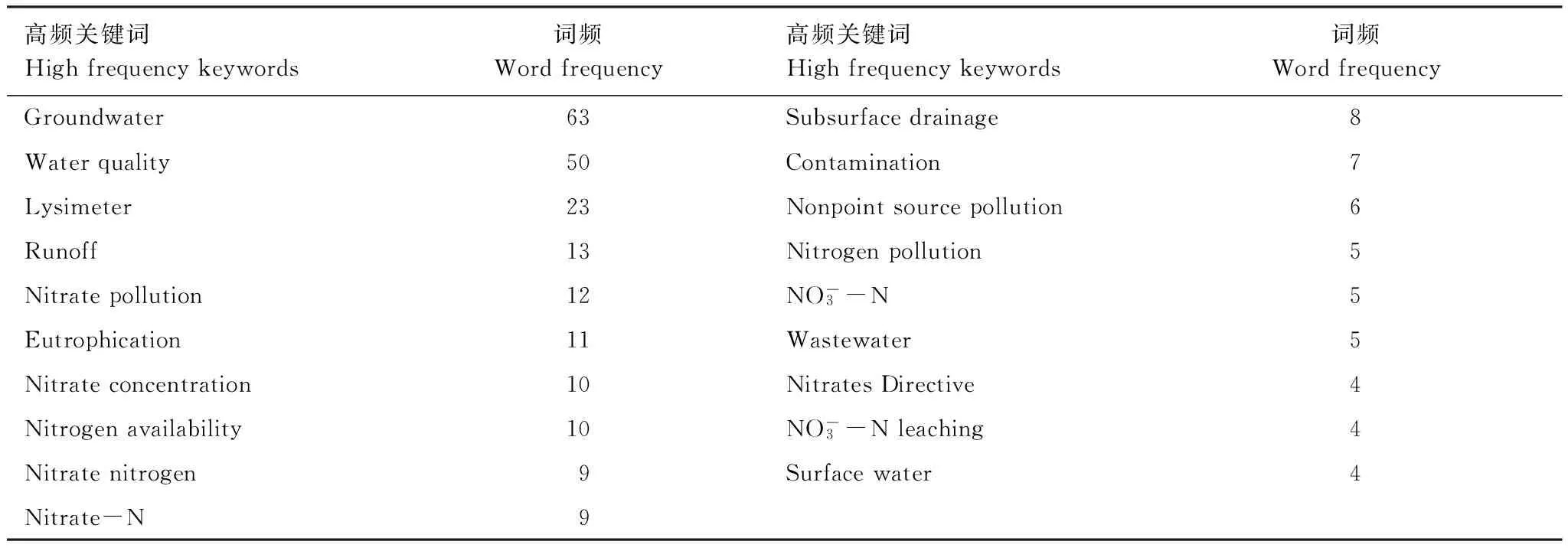
表1 水体水质主题前20位关键词频词
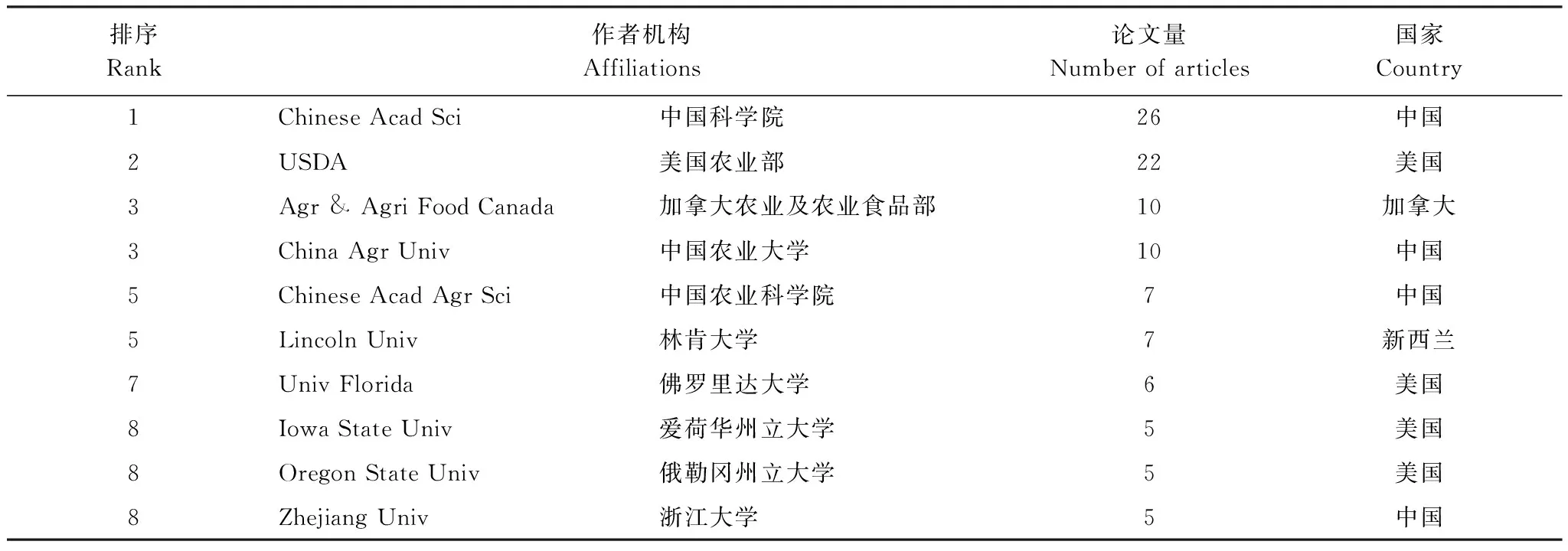
表2 水体水质主题发文量前10位的机构
1.3 主流期刊和高被引论文
刊发农田氮肥施用对水体水质影响研究论文排名前10位的英文期刊主要在欧美国家,中国的优秀英文期刊也对这一研究领域较为关注(表3),从期刊发文量来看,发文量最多的3个期刊均来自荷兰,分别是AGRICULTURAL WATER MANAGEMENT (21篇)、AGRICULTURE ECOSYSTEMS & ENVIRONMENT(21篇)和NUTRIENT CYCLING IN AGROECOSYSTEMS(13篇),来自中国的PEDOSPHERE刊发了10篇相关文章,排在了并列第四位。欧美国家之所以重视这一领域研究论文的刊发,一方面在于其研究水平较高,另一方面在于发达国家对于生态环境与人类健康关系的关注;欧美国家的水体水质也曾经历了不断恶化的阶段,但在农业面源污染的概念提出以来,农田施氮与人体健康的关系也备受关注,并出台了一系列防控措施,最具代表性的就是欧盟颁布并实施的《硝酸盐法令》,一些国家对特定农田、特定肥料的用量也均有限制施用标准。
该研究领域SCI论文被引频次排名前五位的文章主要出自美国、新西兰、中国和以色列(表4),被引频次最高的文章是波士顿大学的Valiela, I于1997年在《ECOLOGICAL APPLICATIONS》杂志上发表的论文《Nitrogen loading from coastal watersheds to receiving estuaries: New method and application》,被引用了220次,该文详述了估算入湖负荷的新方法。新西兰林肯大学的Di, HJ综述了各类型土地利用方式的硝态氮淋失,阐述了合理施氮减少硝态氮淋失的重要性,其论文被引用了152次。中国农业大学的Ju, XT研究了中国山东地区作物系统的地下水硝态氮浓度差异,指出了氮肥过量施用可能是造成地下水硝态氮浓度超标的重要原因,其论文被引用了124次。中国农业大学Liu, XJ教授详述了不同施氮条件下,深层(0—300 cm)土壤硝态

图1 水体水质主题相关关系图Fig.1 Affinity diagram on the topic of water quality
氮的多年分布特征,指出硝态氮淋失出100 cm是华北小麦-玉米轮作氮损失的主要途径,其论文被引用了103次。以色列理工学院的Shaviv, A综述了缓控释肥的农学效应和环境效应,阐明了控释肥施用对作物生长的促进作用,也详述了氮肥施用(其中包括氮淋失)对环境的不利影响,这有助于我们全面认识肥料效应,其论文被引用了101次。
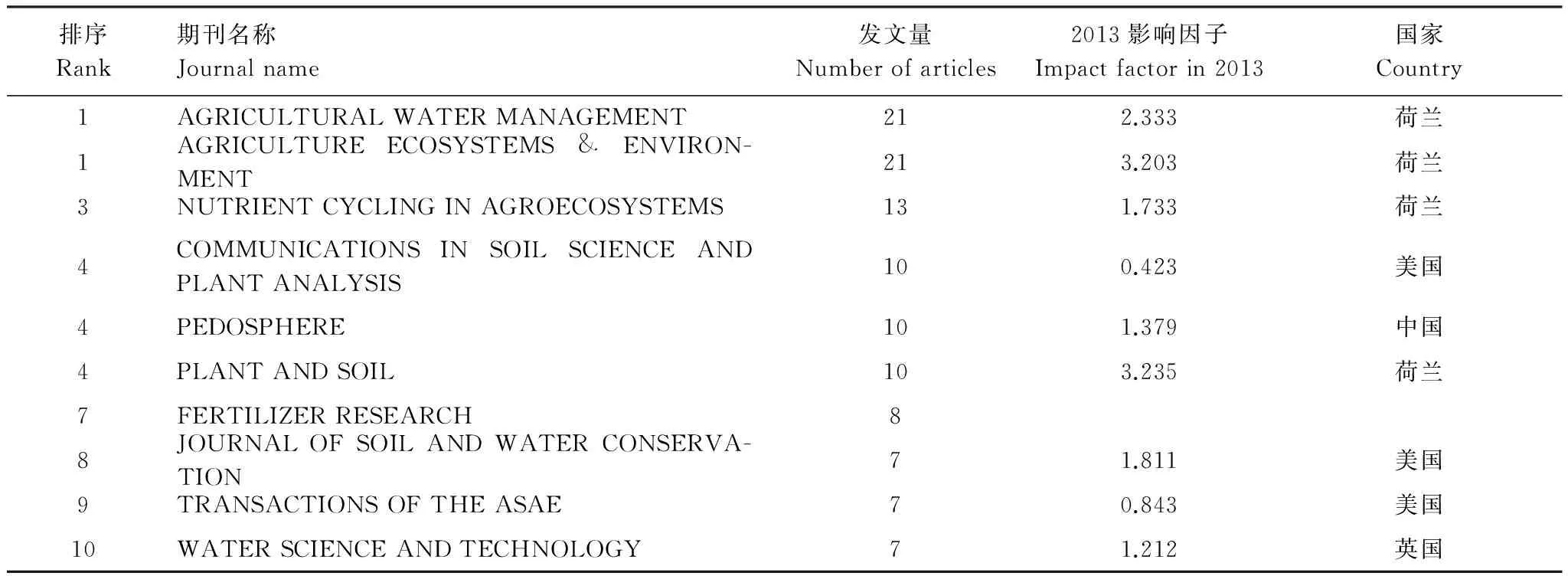
表3 水体水质主题发文量前10位的期刊

表4 水体水质主题排名前5位热点论文
2 农田氮流失量及其影响因素
受地形地貌、土地利用、农田管理措施等多种因素的影响,不同地区研究中的氮素流失量差别很大,同一地区不同土壤、不同种植模式之间的氮流失量也有较大差异,整体而言,世界各国氮素损失量均表现为随施氮量增加而显著增加[23- 24]。中国农田施氮量普遍较高,由此造成的氮流失问题也很严重(表5),相对中国而言,英、美等发达国家的关于农田氮素流失的研究中很少关注高量施氮,这可能是这些国家已经采取了一系列措施从源头上降低了过量施氮,较低的施氮条件下,其氮素流失量也相对较少。
相对较少,可能与这些国家较早地关注农业面源污染,并积极采取了防控措施有关,尤其是颁布的限制农田氮素施用的法令,在减少氮流失方面效果显著。
氮素在土壤中的残留和累积是其流失的前提和物质基础;进入农田的水分溶解并携带土壤氮向不同方向迁移,最终将其带出农田或根区从而导致氮素流失,因此,凡是能够改变土壤氮素累积和水分运移的因素都会影响氮素流失的发生。农田氮素流失发生过程受多种因素影响[41],农田固有的特点如地形地貌、土壤质地等影响氮素的本底流失,而种植模式、施肥、灌溉等管理措施是导致氮素流失量变化的直接原因,并且各影响因素中,只有部分农田管理措施是可以控制调节的,固有的气候气象和土壤条件等是无法改变的。
降雨是产生氮流失的先决条件,雨强、时长等直接决定了径流或淋溶量的大小。通常情况下,氮素流失主要发生在降雨或灌溉集中的季节,强降雨和较为常见的大水漫灌会为氮素迁移提供便利条件,是导致氮流失发生的重要时期[41- 42]。地形影响地表水热条件的重新分配,尤其坡度能直接支配地表径流,是影响土壤氮素流失最重要的地形因素。当坡度较小时,氮主要通过随水向下渗透而淋失,随径流流失量较少;当坡度较大时,表层土壤易遭到侵蚀,氮主要通过随地表水流动迁移而发生径流流失,向下淋失较少。在一定范围内,坡度越大,氮素随水土流失越严重[43]。此外,氮素流失量与坡度的关系还受植被覆盖、坡长、径流时间等多种因素影响[44- 45]。
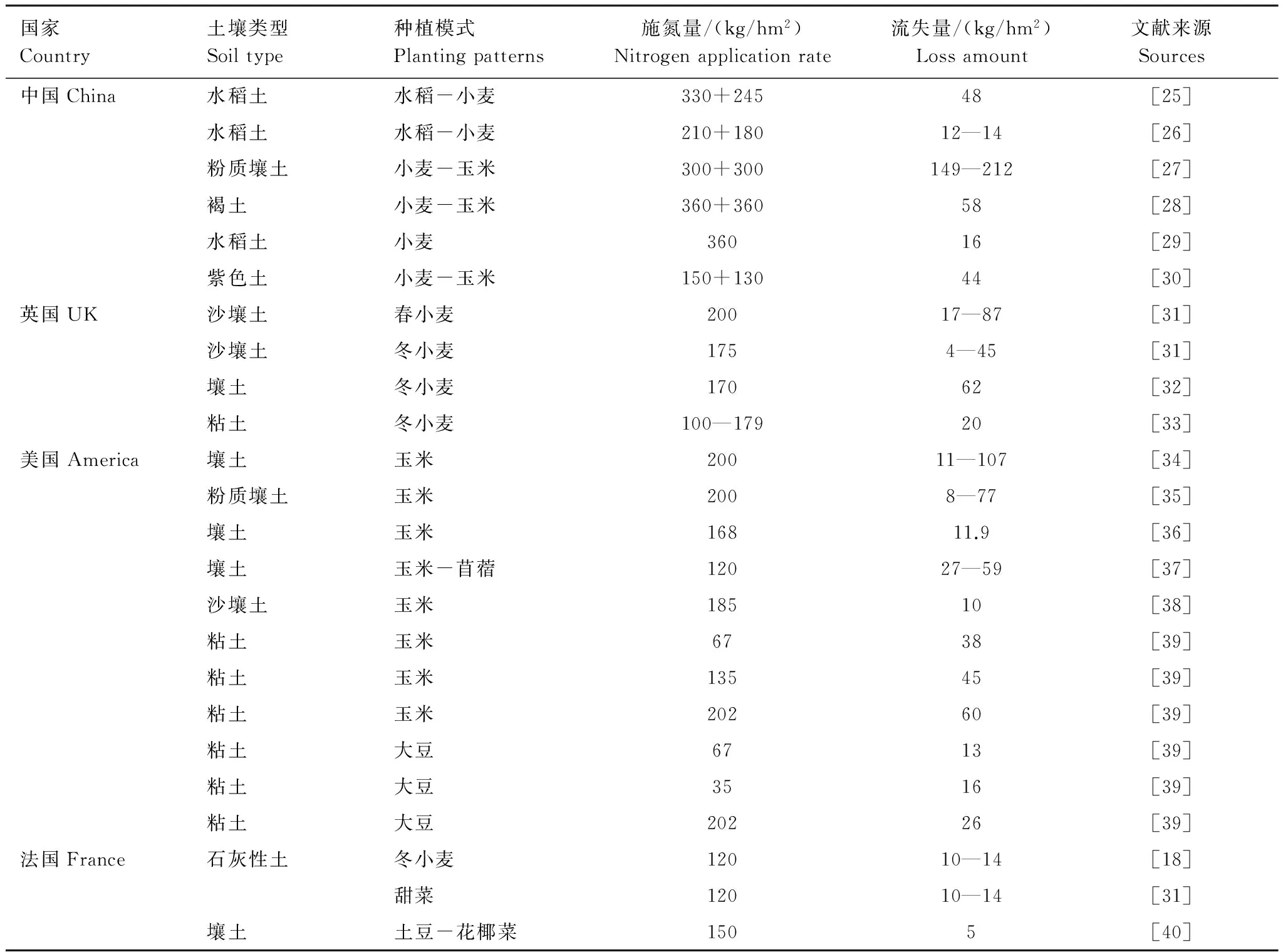
表5 国内外典型种植模式农田氮流失量差异
土壤质地决定了水分的渗透性[46],土壤大孔隙是氮素迁移的主要通道,土壤质地越粗、孔隙越多,淋溶损失越严重;卵石和砂砾土中氮素的流失量较大,而粘质和粉砂质土壤反硝化作用较强,加之氮淋溶速度很慢,因而淋失量较小[46]。偶尔在粘质土壤中观测到的较大的硝态氮淋失可能也是由于大孔隙的存在造成的[46]。不同的土地利用方式导致不同程度的水土和养分流失,相同土壤类型下,粮田的氮负荷要高于果园和林地[46],而种植蔬菜的农田养分流失量明显高于作物轮作种植模式[47]。
施氮量、氮肥种类、施用时期等都与氮流失量密切相关,施氮量与氮流失量之间存在显著的正相关关系[48],对氮素径流的发生起主导作用,正常水文年,施氮量的增加会显著增加径流水的氮含量[25]。适当的有机肥处理与化肥处理相比可显著减少氮素流失,缓控释肥可以控制氮素释放,提高氮素利用率,进一步降低氮素流失风险[49]。氮素流失多发生在多雨季节,施肥时间与产流时间越近,径流硝态氮浓度越高,因此避开雨期施肥可显著降低氮素流失量[50],同时水肥耦合也能明显减少氮素流失[51],优化施肥的同时优化灌溉更能实现经济和环境效益双赢[52]。
3 氮肥施用对氮流失的影响
化肥尤其是氮肥为我国粮食持续增产做出了重要贡献(图2)。我国粮食产量由1979年的3.32亿t增加到2012年的5.90亿t,单产也从2,237 kg/hm2增加到3,608 kg/hm2。2012年,全球化肥和氮肥消费量分别为1.70亿t和1.03亿t,单位播种面积用量分别为87.5 kg/hm2和52.9 kg/hm2,而我国化肥和氮肥用量分别为5839万t、2698万t,单位播种面积化肥(357.3 kg/hm2)和氮肥(165.1 kg/hm2)施用量均远高于世界平均用量。全球主要粮食作物(水稻、小麦、玉米)产量25.5亿t,其中中国生产了5.41亿t[53],我国以世界26%的氮肥消费量生产了世界21%的粮食,较低的氮肥利用率,势必造成资源的浪费和潜在的环境风险。
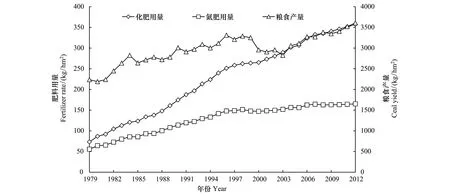
图2 单位农田种植面积肥料用量和粮食产量(1979—2012)(中国统计年鉴,2013)Fig.2 Fertilizer rate and food production of per hectare farmland (1979—2102) (China Statistical Yearbook, 2013)
目前全球氮肥用量相比20世纪增加了100倍,其中60%的氮肥被用于主要粮食作物的生产。据估计,到2050年世界人口将达到93亿,对粮食的需求将增加50%—70%,如果氮肥利用率不能明显提高,氮肥总投入量需要在目前的基础上再增加1倍才能满足人类对粮食的需求[54]。中国粮食作物氮肥利用率远低于世界平均水平,有研究指出,我国小麦和玉米氮肥利用率分别为28%和26%[55],而世界平均水平为54%和63%[18,54,56]。相应地,我国土壤氮素残留率较高,但下茬作物对残留的氮素利用有限[57],大多氮素最终流失出农田,进入环境导致生态系统功能退化。目前,农业已成为陆地生态系统中重要的氮素排放源,也是大多数河流湖泊水体污染主因之一,因此,农田氮素流失规律及防控措施研究应受到重视[4,58]。
4 农田氮流失防控措施
大量研究表明农田氮素流失是目前诸多水体水质恶化的重要原因,源头控制和氮迁移过程拦截是控制农田氮素流失的主要策略。优化农艺管理措施,在源头上避免土壤扰动造成的水土迁移,减少不合理灌溉造成的农田排水,也可显著减少氮素流失;在氮素出田至进入水体迁移过程中,利用人工湿地、缓冲带等工程措施,可以进一步减少进入水体的氮量。研究表明,合理的农田管理措施如优化施肥和种植结构、保护耕地、节水灌溉等可减少15%—92%的氮素流失,而缓冲带、人工湿地、径流拦截等迁移过程控制措施可减少50%—77%的氮素损失(表6)。对于何种措施防控效果更好,并没有严格的评价标准。氮素迁移过程控制措施大都是工程技术措施,建设难度较高,而我国农田面积大,地形复杂,缓冲带、人工湿地等氮素迁移过程阻断工程建设普及难度较大[59]。因地制宜地采取合理的农田管理措施,尤其是优化施肥、优化种植结构、保护性耕作及节水灌溉[60- 62]等措施更易推广普及。

表6 氮素流失防控措施
优化农田施氮量可从源头上减少氮随水流失的发生机率[64,69],是众多防控措施之中最节约成本、节省劳力、最易被农民接受的方法[70]我国农田面积大而单户农田面积较小,受气候、地形、种植模式、政策等诸多因素的影响,基于不同目的确定田块尺度适宜施氮量的方法多种多样(表7)。以满足作物生长发育过程中氮素需求为目的方法,包括利用叶绿素仪监测作物长势、根据土壤无机氮含量进行氮素实时监测调控、借助长期定位监测建立经验施肥模型等,此类方法的特点是可以指导何时施氮,确定经验施氮量,间接缓解了环境污染风险,但是这一方法是以满足作物养分需求为主,并不直接考虑环境效应。以获得最高产量或经济效益为目的的方法,包括测土配方施肥、建立氮肥-产量或氮肥-经济效益效应曲线等,其特点是可以通过明显的突变点确定基于作物最高产量或经济效益的施氮量。以氮肥环境风险估算为目的的方法,包括氮淋失潜力估算、各种氮素损失风险估算模型等,其中采取表观平衡法核算农田氮素投入与支出比例,减少土壤氮素盈余是目前最常用的确定适宜施氮量的方法[23,71],其特点是没有明显的突变点,仅局限于风险评估,也就是环境风险之间的相互比较,不能直接确定造成环境污染突变的施氮临界值。以执行相关规章制度为目的方法,包括执行相关环境保护规章、根据环保法规限定施氮量及施氮时期[72- 73]等,但这一方法是建立在对某一环境指标有明确的限制性规定基础上的,如欧盟实施已久的《硝酸盐法案》中规定有机肥氮用量不能高于170 kg/hm2,这也是农田施氮与环境目标联系最为密切的确定施氮临界值方法,但这一方法多用于后期监测调整管理措施。以上各种方法均是在田块尺度确定的适宜施氮量,然而在区域尺度上仍然缺乏较统一的施氮量,中国科学院南京土壤研究所的朱兆良院士首先提出了区域平均适宜施氮量的概念[74],并实地验证了区域平均适宜施氮量的合理性和可行性[75],这为区域尺度氮肥管理提供了参考。
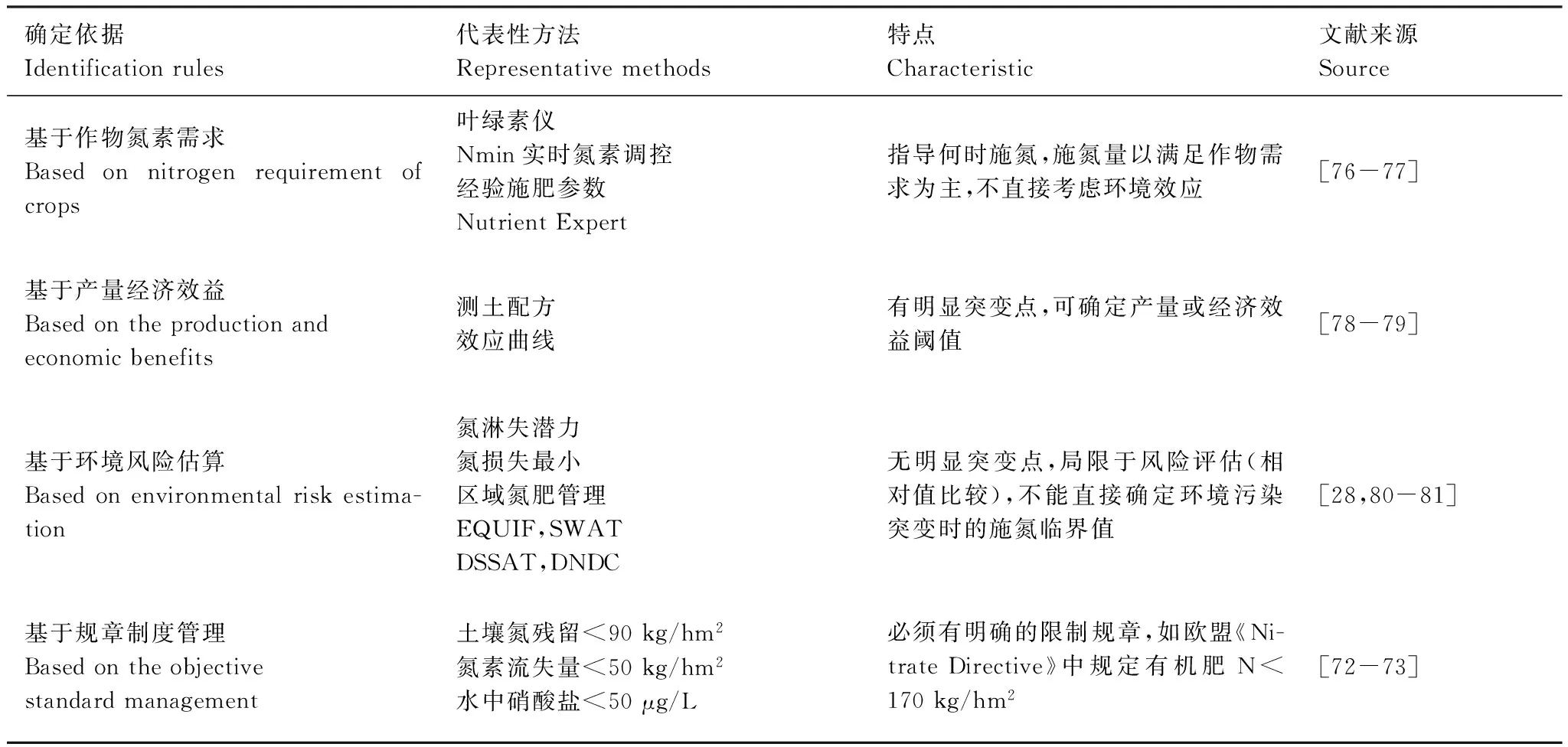
表7 农田适宜施氮量的确定方法
5 问题与展望
现有研究中所阐述的农田氮素流失量多数为出田氮量,而对于流失出田的氮素如何迁移进入水体以及这一迁移过程中的氮形态变化特征仍不清楚;此外,淋失出根区或径流出农田的氮素虽然并未直接进入环境,但这些氮素难以再被利用而成为严重的污染源,因此,今后的研究除了要精确量化农田氮素出田外,还要进一步阐明氮素在出田至目标水体这一阶段内的变化特征,并积极探索消除农田氮流失环境风险的有效措施。
农田氮流失的发生及其流失量受多种因素影响,分析当前氮肥施用现状,揭示氮素向水体的迁移规律,有助于制定合理、有效的针对性氮流失防控措施。诸多农田管理措施中,施氮量是最直接、最易控制的关键管理措施,在保证一定粮食产量的基础上,确定基于环境安全尤其是水质保护的合理农田施氮量是可行的,也是平衡产量需求与环境污染之间矛盾的有效措施。然而,当前种植业面源污染愈加严重,为防治由此造成的水体水质持续恶化,迫切需要制定以水质保护为目标的农田氮肥施用阈值(造成水质污染的施氮临界值),全国各大高校及科研院所也都为实现这一目标不断努力,但是目前在这一研究方向上并无突破。
目前,确定田块尺度适宜施氮量的方法较多,但在区域尺度上,随着农田面源氮污染问题日益突出,控制区域氮肥用量越来越重要,而要解决这一问题,应当建立区域乃至全国范围内的农业面源污染监测网络,在长期定位监测基础上,创建合理的面源氮污染核算方法,测算出种植业源污染物产生与排放系数,并明确农田氮肥施用与水体水质的关系,最终确定导致水体污染的氮肥施用临界值。
致谢:中国科学院文献情报中心在文献检索和数据分析过程中给予帮助,彭皓老师帮助写作,特此致谢。
[1] Erisman J W, Sutton M A, Galloway J, Klimont Z, Winiwarter W. How a century of ammonia synthesis changed the world. Nature Geoscience, 2008, 1(10): 636- 639.
[2] Malhi S S, Grant C A, Johnston A M, Gill K S. Nitrogen fertilization management for no-till cereal production in the Canadian Great Plains: a review. Soil & Tillage Research, 2001, 60(3/4): 101- 122.
[3] Li S X, Wang Z H, Hu T T, Gao Y J, Stewart B A. Nitrogen in dryland soils of china and its management//Sparks D L, ed. Advances in Agronomy. New York: Academic Press, 2009: 123- 181.
[4] Cameron K C, Di H J, Moir J L. Nitrogen losses from the soil/plant system: a review. Annals of Applied Biology, 2013, 162(2): 145- 173.
[5] Vitousek P M, Naylor R, Crews T, David M B, Drinkwater L E, Holland E, Johnes P J, Katzenberger J, Martinelli L A, Matson P A, Nziguheba G, Ojima D, Palm C A, Robertson G P, Sanchez P A, Townsend A R, Zhang F S. Nutrient imbalances in agricultural development. Science, 2009, 324(5934): 1519- 1520.
[6] Cui Z L, Chen X P, Zhang F S. Current nitrogen management status and measures to improve the intensive wheat-maize system in China. AMBIO, 2010, 39(5/6): 376- 384.
[7] Ju X T, Xing G X, Chen X P, Zhang S L, Zhang L J, Liu X J, Cui Z L, Yin B, Christie P, Zhu Z L, Zhang F S. Reducing environmental risk by improving N management in intensive Chinese agricultural systems. Proceedings of the National Academy of Sciences of the United States of America, 2009, 106(9): 3041- 3046.
[8] Howarth R W. An assessment of human influences on fluxes of nitrogen from the terrestrial landscape to the estuaries and continental shelves of the North Atlantic Ocean. Nutrient Cycling in Agroecosystems, 1998, 52(2/3): 213- 223.
[9] Zhang W L, Tian Z X, Zhang N, Li X Q. Nitrate pollution of groundwater in northern China. Agriculture, Ecosystems & Environment, 1996, 59(3): 223- 231.
[10] Spiertz J H J. Nitrogen, sustainable agriculture and food security. A review. Agronomy for Sustainable Development, 2010, 30(1): 43- 55.
[11] Liu X J, Zhang L, Hong S. Global biodiversity research during 1900- 2009: a bibliometric analysis. Biodiversity and Conservation, 2011, 20(4): 807- 826.
[12] Li J F, Wang M H, Ho Y S. Trends in research on global climate change: A science citation index expanded-based analysis. Global and Planetary Change, 2011, 77(1/2): 13- 20.
[13] Wang M H, Li J F, Ho Y S. Research articles published in water resources journals: A bibliometric analysis. Desalination and Water Treatment, 2011, 28(1/3): 353- 365.
[14] Huang W L, Zhang B G, Feng C P, Li M, Zhang J. Research trends on nitrate removal: a bibliometric analysis. Desalination and Water Treatment, 2012, 50(1/3): 67- 77.
[15] Monge-Nájera J, Ho Y S. Costa rica publications in the science citation index expanded: a bibliometric analysis for 1981- 2010. Revista de Biologia Tropical, 2012, 60(4): 1649- 1661.
[16] Valkama E, Salo T, Esala M, Turtola E. Nitrogen balances and yields of spring cereals as affected by nitrogen fertilization in northern conditions: A meta-analysis. Agriculture, Ecosystems & Environment, 2013, 164: 1- 13.
[17] Carpenter S R, Caraco N F, Correll D L, Howarth R W, Sharpley A N, Smith V H. Nonpoint pollution of surface waters with phosphorus and nitrogen. Ecological Applications, 1998, 8(3): 559- 568.
[18] Sebilo M, Mayer B, Nicolardot B, Pinay G, Mariotti A. Long-term fate of nitrate fertilizer in agricultural soils. Proceedings of the National Academy of Sciences of the United States of America, 2013, 110(45): 18185- 18189.
[19] Fungaroli A A, Steiner R L, Remson I. Design of A Sanitary Landfill Laboratory Lysimeter. 1900.
[20] Peierls B L, Caraco N F, Pace M L, Cole J J. Human influence on river nitrogen. Nature, 1991, 350(6317): 386- 387.
[21] Smith R A, Alexander R B, Wolman M G. Water-quality trends in the nation′s rivers. Science, 1987, 235(4796): 1607- 1615.
[22] Lin K F, Xiang Y L, Liu X F, Pastore G. Loss of nitrogen, phosphorus, and potassium through crop harvests in agroecosystems of Qianjiang, Hubei province, PR China. Critical Reviews in Plant Sciences, 1999, 18(3): 393- 401.
[23] Song X Z, Zhao C X, Wang X L, Li J. Study of nitrate leaching and nitrogen fate under intensive vegetable production pattern in northern China. Comptes Rendus Biologies, 2009, 332(4): 385- 392.
[24] Sogbedji J M, Van Es H M, Yang C L, Geohring L D, Magdoff F R. Nitrate leaching and nitrogen budget as affected by maize nitrogen rate and soil type. Journal of Environmental Quality, 2000, 29(6): 1813- 1820.
[25] Tian Y H, Yin B, Yang L Z, Yin S X, Zhu Z L. Nitrogen runoff and leaching losses during rice-wheat rotations in Taihu Lake Region, China. Pedosphere, 2007, 17(4): 445- 456.
[26] Yu Y L, Xue L H, Yang L Z. Winter legumes in rice crop rotations reduces nitrogen loss, and improves rice yield and soil nitrogen supply. Agronomy for Sustainable Development, 2014, 34(3): 633- 640.
[27] Fang Q X, Yu Q, Wang E L, Chen Y H, Zhang G L, Wang J, Li L H. Soil nitrate accumulation, leaching and crop nitrogen use as influenced by fertilization and irrigation in an intensive wheat-maize double cropping system in the North China Plain. Plant and Soil, 2006, 284(1/2): 335- 350.
[28] Huang M X, Liang T, Ouyang Z, Wang L Q, Zhang C S, Zhou C H. Leaching losses of nitrate nitrogen and dissolved organic nitrogen from a yearly two crops system, wheat-maize, under monsoon situations. Nutrient Cycling in Agroecosystems, 2011, 91(1): 77- 89.
[29] Liang X Q, Xu L, Li H, He M M, Qian Y C, Liu J, Nie Z Y, Ye Y S, Chen Y X. Influence of N fertilization rates, rainfall, and temperature on nitrate leaching from a rainfed winter wheat field in Taihu watershed. Physics and Chemistry of the Earth, Parts A/B/C, 2011, 36(9/11): 395- 400.
[30] Wang T, Zhu B, Kuang F H. Reducing interflow nitrogen loss from hillslope cropland in a purple soil hilly region in southwestern China. Nutrient Cycling in Agroecosystems, 2012, 93(3): 285- 295.
[31] Shepherd M A, Lord E I. Nitrate leaching from a sandy soil: The effect of previous crop and post-harvest soil management in an arable rotation. The Journal of Agricultural Science, 1996, 127(2): 215- 229.
[32] Readman R J, Beckwith C P, Kettlewell P S. Effects of spray application of urea fertilizer at stem extension on winter wheat: N recovery and nitrate leaching. The Journal of Agricultural Science, 2002, 139(1): 11- 25.
[33] Catt J A, Howse K R, Christian D G, Lane P W, Harris G L, Goss M J. Strategies to decrease nitrate leaching in the Brimstone Farm Experiment, Oxfordshire, UK, 1988- 1993: The effects of winter cover crops and unfertilised grass leys. Plant and Soil, 1998, 203(1): 57- 69.
[34] Bjorneberg D L, Kanwar R S, Melvin S W. Seasonal changes in flow and nitrate-N loss from subsurface drains. Transactions of the ASABE, 1996, 39(3): 961- 967.
[35] Baker J L, Timmons D R. Fertilizer management effects on leaching of labeled nitrogen for no-till corn in field lysimeters. Journal of Environmental Quality, 1994, 23(2): 305- 310.
[36] Bakhsh A, Kanwar R S, Baker J L. N-application methods and precipitation pattern effects on subsurface drainage nitrate losses and crop yields. Water, Air, & Soil Pollution, 2010, 212(1/4): 65- 76.
[37] Basso B, Ritchie J T. Impact of compost, manure and inorganic fertilizer on nitrate leaching and yield for a 6-year maize-alfalfa rotation in Michigan. Agriculture, Ecosystems & Environment, 2005, 108(4): 329- 341.
[38] Gehl R J, Schmidt J P, Stone L R, Schlegel A J, Clark G A. In situ measurements of nitrate leaching implicate poor nitrogen and irrigation management on sandy soils. Journal of Environmental Quality, 2005, 34(6): 2243- 2254.
[39] Li C S, Farahbakhshazad N, Jaynes D B, Dinnes D L, Salas W, McLaughlin D. Modeling nitrate leaching with a biogeochemical model modified based on observations in a row-crop field in Iowa. Ecological Modelling, 2006, 196(1/2): 116- 130.
[40] Akkal-Corfini N, Morvan T, Menasseri-Aubry S, Bissuel-Bélaygue C, Poulain D, Orsini F, Leterme P. Nitrogen mineralization, plant uptake and nitrate leaching following the incorporation of (15N)-labeled cauliflower crop residues (Brassicaoleracea) into the soil: a 3-year lysimeter study. Plant and Soil, 2010, 328(1/2): 17- 26.
[41] Kakuturu S, Chopra M, Hardin M, Wanielista M. Total nitrogen losses from fertilized turfs on simulated highway slopes in Florida. Journal of Environmental Engineering-ASCE, 2013, 139(6): 829- 837.
[42] Di H J, Cameron K C, Moore S, Smith N P. Nitrate leaching and pasture yields following the application of dairy shed effluent or ammonium fertilizer under spray or flood irrigation: results of a lysimeter study. Soil Use and Management, 1998, 14(4): 209- 214.
[43] Wang H X, Shi Y, Ma J, Lu C Y, Chen X. Characteristics of non-point source N export via surface runoff from sloping croplands in Northeast China. Advanced Materials Research, 2011, 347- 353: 2302- 2307.
[44] Dorofki M, Elshafie A H, Jaafar O, Karim O A, Abdullah S M S. A GIS-ANN-based approach for enhancing the effect of slope in the modified green-ampt model. Water Resources Management, 2014, 28(2): 391- 406.
[45] Xu L, Marinova D. Resilience thinking: a bibliometric analysis of socio-ecological research. Scientometrics, 2013, 96(3): 911- 927.
[46] Witheetrirong Y, Tripathi N K, Tipdecho T, Parkpian P. Estimation of the effect of soil texture on nitrate-nitrogen content in groundwater using optical remote sensing. International Journal of Environmental Research and Public Health, 2011, 8(8): 3416- 3436.
[47] Karcher S C, VanBriesen J M, Nietch C T. Alternative land-use method for spatially informed watershed management decision making using swaT. Journal of Environmental Engineering, 2013, 139(12): 1413- 1423.
[48] Kim J S, Oh S Y, Oh K Y. Nutrient runoff from a Korean rice paddy watershed during multiple storm events in the growing season. Journal of Hydrology, 2006, 327(1/2): 128- 139.
[49] Clark M J, Zheng Y B. Plant nutrition requirements for an installed sedum-vegetated green roof module system: effects of fertilizer rate and type on plant growth and leachate nutrient content. HortScience, 2013, 48(9): 1173- 1180.
[50] Torbert H A, Gerik T J, Harman W L, Williams J R, Magre M. EPIC Evaluation of the Impact of Poultry Litter Application Timing on Nutrient Losses. Communications in Soil Science and Plant Analysis, 2008, 39(19- 20): 3002- 3031.
[51] Qian X Y, Shen G X, Gu H R, Pugliese M, Gullino M L. Effects of drip fertigation management on nutrient losses and pear production at Chongming Dongtan in Yangtze River Estuary, China. Advanced Materials Research, 2011, 396- 398: 1716- 1724.
[52] Zhang X, Huang G, Bian X, Zhao Q. Effects of root interaction and nitrogen fertilization on the chlorophyll content, root activity, photosynthetic characteristics of intercropped soybean and microbial quantity in the rhizosphere. Plant, Soil and Environment, 2013, 59(2): 80- 88.
[53] FAO. FAOSATA. http://faostat.fao.org/site/339/default.aspx. 2014.
[54] Ladha J K, Pathak H, Krupnik T J, Six J, Van Kessel C. Efficiency of fertilizer nitrogen in cereal production: Retrospects and prospects. Advances in Agronomy, 2005, 87: 85- 156.
[55] 张福锁, 王激清, 张卫峰, 崔振岭, 马文奇, 陈新平, 江荣风. 中国主要粮食作物肥料利用率现状与提高途径. 土壤学报, 2008, 45(5): 915- 924.
[56] Goulding K W T, Poulton P R, Webster C P, Howe M T. Nitrate leaching from the Broadbalk Wheat Experiment, Rothamsted, UK, as influenced by fertilizer and manure inputs and the weather. Soil Use and Management, 2000, 16(4): 244- 250.
[57] Liang B, Zhao W, Yang X Y, Zhou J B. Fate of nitrogen- 15 as influenced by soil and nutrient management history in a 19-year wheat-maize experiment. Field Crops Research, 2013, 144: 126- 134.
[58] Birgand F, Skaggs R W, Chescheir G M, Gilliam J W. Nitrogen removal in streams of agricultural catchments-A literature review. Critical Reviews in Environmental Science and Technology, 2007, 37(5): 381- 487.
[59] Kuusemets V, Mander Ü. Ecotechnological measures to control nutrient losses from catchments. Water Science and Technology, 1999, 40(10): 195- 202.
[60] Wang Q, Li F R, Zhao L, Zhang E H, Shi S L, Zhao W Z, Song W X, Vance M M. Effects of irrigation and nitrogen application rates on nitrate nitrogen distribution and fertilizer nitrogen loss, wheat yield and nitrogen uptake on a recently reclaimed sandy farmland. Plant and Soil, 2010, 337(1/2): 325- 339.
[61] Shan N, Ruan X H, Xu J, Pan Z R. Estimating the optimal width of buffer strip for nonpoint source pollution control in the Three Gorges Reservoir Area, China. Ecological Modelling, 2014, 276: 51- 63.
[62] Cui F, Zheng X H, Liu C Y, Wang K, Zhou Z X, Deng J. Assessing biogeochemical effects and best management practice for a wheat-maize cropping system using the DNDC model. Biogeosciences, 2014, 11(1): 91- 107.
[63] Pappa V A, Rees R M, Walker R L, Baddeley J A, Watson C A. Nitrous oxide emissions and nitrate leaching in an arable rotation resulting from the presence of an intercrop. Agriculture, Ecosystems & Environment, 2011, 141(1/2): 153- 161.
[64] Ruidisch M, Bartsch S, Kettering J, Huwe B, Frei S. The effect of fertilizer best management practices on nitrate leaching in a plastic mulched ridge cultivation system. Agriculture, Ecosystems & Environment, 2013, 169: 21- 32.
[65] Kurothe R S, Kumar G, Singh R, Singh H B, Tiwari S P, Vishwakarma A K, Sena D R, Pande V C. Effect of tillage and cropping systems on runoff, soil loss and crop yields under semiarid rainfed agriculture in India. Soil & Tillage Research, 2014, 140: 126- 134.
[66] Wang L M, Duggin J A, Nie D P. Nitrate-nitrogen reduction by established tree and pasture buffer strips associated with a cattle feedlot effluent disposal area near Armidale, NSW Australia. Journal of Environmental Management, 2012, 99: 1- 9.
[67] Abbassi B, Al-Zboon K, Radaideh J, Wahbeh A. Using constructed wetlands to improve drainage water quality from hydroponics farms. Irrigation and Drainage, 2011, 60(3): 370- 380.
[68] Kovacic D A, David M B, Gentry L E, Starks K M, Cooke R A. Effectiveness of constructed wetlands in reducing nitrogen and phosphorus export from agricultural tile drainage. Journal of Environmental Quality, 2000, 29(4): 1262- 1274.
[69] Min J, Zhang H L, Shi W M. Optimizing nitrogen input to reduce nitrate leaching loss in greenhouse vegetable production. Agricultural Water Management, 2012, 111: 53- 59.
[70] Wang W N, Lu J W, Ren T, Li X K, Su W, Lu M X. Evaluating regional mean optimal nitrogen rates in combination with indigenous nitrogen supply for rice production. Field Crops Research, 2012, 137: 37- 48.
[71] Min J, Zhao X, Shi W M, Xing G X, Zhu Z L. Nitrogen balance and loss in a greenhouse vegetable system in southeastern China. Pedosphere, 2011, 21(4): 464- 472.
[72] Schröder J J, Neeteson J J. Nutrient management regulations in The Netherlands. Geoderma, 2008, 144(3/4): 418- 425.
[73] Nevens F, Reheul D. Agronomical and environmental evaluation of a long-term experiment with cattle slurry and supplemental inorganic N applications in silage maize. European Journal of Agronomy, 2005, 22(3): 349- 361.
[74] 朱兆良, 张绍林, 徐银华. 平均适宜施氮量的含义. 土壤, 1986, 18(6): 316- 317.
[75] 晏娟. 太湖地区稻麦轮作体系氮肥适宜用量及提高其利用效率的研究[D]. 南京: 南京农业大学, 2009.
[76] Hou P, Gao Q, Xie R Z, Li S K, Meng Q F, Kirkby E A, Römheld V, Müller T, Zhang F S, Cui Z L, Chen X P. Grain yields in relation to N requirement: Optimizing nitrogen management for spring maize grown in China. Field Crops Research, 2012, 129: 1- 6.
[77] Xu X P, He P, Qiu S J, Pampolino M F, Zhao S C, Johnston A M, Zhou W. Estimating a new approach of fertilizer recommendation across small-holder farms in China. Field Crops Research, 2014, 163: 10- 17.
[78] Cui Z L, Chen X P, Zhang F S. Development of regional nitrogen rate guidelines for intensive cropping systems in China. Agronomy Journal, 2013, 105(5): 1411- 1416.
[79] Xia Y Q, Yan X Y. Ecologically optimal nitrogen application rates for rice cropping in the Taihu Lake region of China. Sustainability Science, 2012, 7(1): 33- 44.
[80] Deng J, Zhou Z, Zhu B, Zheng X, Li C, Wang X, Jian Z. Modeling nitrogen loading in a small watershed in southwest China using a DNDC model with hydrological enhancements. Biogeosciences, 2011, 8(10): 2999- 3009.
[81] Aveline A, Rousseau M L, Guichard L, Laurent M, Bockstaller C. Evaluating an environmental indicator: Case study of MERLIN, a method for assessing the risk of nitrate leaching. Agricultural Systems, 2009, 100(1/3): 22- 30.
ZHANG Yitao1, LIU Hongbin1, WANG Hongyuan1, ZHAI Limei1, LIU Shen1, LEI Qiuliang1, REN Tianzhi2,*
1MinistryofAgricultureKeyLaboratoryofNonpointSourcePollutionControl/InstituteofAgriculturalResourcesandRegionalPlanning,ChineseAcademyofAgriculturalSciences,Beijing100081,China
2Agro-EnvironmentalProtectionInstitute,MinistryofAgriculture,Tianjin300191,China
A bibliometric analysis method was used to identify the developmental trend of international research on nitrogen losses in farmlands as affected by nitrogen applications, based on peer-reviewed studies available in the ISI Web of Science since 1957. We also reviewed control and prevention measures for farmland nitrogen loss, with the same method. The bibliometric analysis showed that the current focus of research regarding nitrogen losses worldwide involved assessing and monitoring of the effects of nitrogen fertilization on water pollution and quality. Keywords included Groundwater, Water quality, Surface water, Nitrate pollution, Eutrophication, Contamination, Nonpoint source pollution, Lysimeter, Runoff, and Subsurface drainage, etc. Research institutions that contributed to a large number of research findings are mainly resided in large agricultural countries, including China, United States, and Canada, and the mainstream journals that included most relevant papers are published in the Netherlands, United States, and China. Literature analysis showed that nitrogen losses are site-specific because it can be influenced by precipitation, topography, soil properties, and forms, rates, timing and placement of fertilizers, as well as other management practices. Nitrogen losses in China (13.7—347 kg/hm2) was significantly higher than that of countries in Europe and North America (4—107 kg/hm2). On average, the fertilizer use is 357.3 kg/ hm2and nitrogen rate is 165.1 kg/hm2in China, which was much higher than the world average application rates (fertilizer rate: 87.5 kg/hm2; nitrogen rate: 52.9 kg/hm2). As a result, nitrogen use efficiency during one crop growth period in China (17%) was significantly lower than the world average (58%). These results indicated that excessive fertilizer application and underutilization of nitrogen were main reasons for nitrogen losses to surface and ground water. By comprehensively analyzing prevention and control measures for farmland nitrogen losses, we found that reducing nitrogen losses from the source was the most effective measure. Optimizing agronomic management practices and intercepting nitrogen migration could reduce nitrogen losses by 15% to 82%. Among a large diversity of studies, the largest group of studies focused on optimizing nitrogen applications. However, faced with resource shortage, water quality deterioration, and food production pressure, future research focus should shift from nitrogen balance to study of the nitrogen cycle in the entire farmland ecosystem. Further, there is an urgent need to determine nitrogen fertilization thresholds (critical nitrogen levels resulting in risk of pollution) for water quality protection. Effective prevention and control measures for nitrogen losses will provide theoretical and technical supports to balance the conflicts among food demand, resource conservation, and environmental protection.
farmland nitrogen; Web of Science; water quality; N loss; prevent and control measures; critical nitrogen rate
公益性行业(农业)科研专项(201303089, 201003014)
2015- 04- 14;
日期:2016- 01- 22
10.5846/stxb201504140764
*通讯作者Corresponding author.E-mail: rentianzhi@caas.cn
张亦涛,刘宏斌,王洪媛,翟丽梅,刘申,雷秋良,任天志.农田施氮对水质和氮素流失的影响.生态学报,2016,36(20):6664- 6676.
Zhang Y T, Liu H B, Wang H Y, Zhai L M, Liu S, Lei Q L, Ren T Z.A bibliometric analysis of status and trend of international research on field nitrogen application effects on nitrogen losses and water quality.Acta Ecologica Sinica,2016,36(20):6664- 6676.
